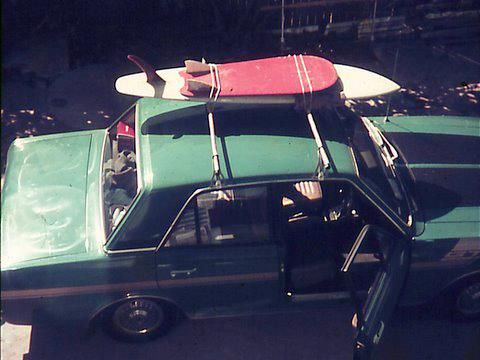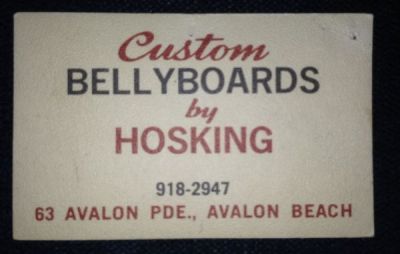A Paipo
Interview with Robert Hosking
July 6, 2016 - Sydney, Australia
E-mail questions by Bob Green
Robert was one of a group of young, local surfers who
rode the hollow
waves of Avalon which was ideally suited to bellyboards and
bodysurfing. In addition to riding waves, Robert made boards for sale.
Impressed by his entrepreneurship, a friend's father even made business
cards for him. Interestingly, at this time Robert learned that his
great
uncle also rode wooden bellyboards when he was a youth, but on the
other
side of the continent.
|
1. I've
seen the 1932 photo of your uncle, Dr. Huntly Higgins, with
bellyboards. Did you know of his background with bellyboards and was
this common interest something that you discussed with him?
I did not know of this background. These
photos were distributed at his
funeral. My father was the Scoutmaster at the time and probably knew
of these exercises. He often spoke of using this type of board at
Cottesloe while I was building mine (see Note 1).
Dr.
Huntly Gordon Higgins with Scarborough Scouts, January 1932, on land
and in the sea. In the Scouts' surfing photo, lower right, from left to
right: H. Gordon Higgins, R.D/G Royce, G. Moore, C. Spivey, G.
Knapton, L. Bowen. Absent from the "boarders" were B. Forster and J.
Atkins.
|

|
|

|
Photo courtesy of Robert
Hosking.
2. What was the background to you making your first
board in 1962? Were there many other paipo riders around at the time?
No,
not at all. Peter Sobels, whose background was in the family furniture
business built a couple, (I recently discovered that he lived next door
to one of my close Architecture mates in Hunters Hill) and then I
started making them. I'd made myself a few handboards by that time and
was out in the surf on foam plastic surfoplanes (a term or model of
surf mat, see Note 2). My first was made in
builder's ply, which I tried to waterproof with black epoxy resin, and
a red fin with two chrome plated brass handles. It didn't last long.
To me, they were not paipos: A spoon is a paipo, narrow at the front
and wider at the back, ala Greenough.
3. What were your boards like? How did the longer 4-ft.
boards compare to the shorter 3-ft. boards?
They evolved over time:
(i) 3' (36 inches): Wider at the front and tapered towards the back,
curved cutout
at the back. 3/8 inch Cemac Seaply, first painted (by hand) with Marine
Varnish, then with Dulux varnish (much better). First single wooden
fin, then glass fin, then double glass fins. 45 shillings.
(ii) 3'6" (42 inches): Basically the same, still 3/8 inch Seaply, but
using
Taubman's solid colors (didn't show the staining: I trialled different
paints, and this was by far the best!!). Back to wood for the fins,
using the cutout ply from the back of the boards.
(iii) 3'6" (42 inches): Paipo shaped (i.e., wider in tail than nose),
but not spooned. Basically the same design
back to front. Easier to catch a wave with, but nose dived easily (of
course!).
(iv) 4' and a bit (48+ inches): Angled them slightly to get the best
use out of
the ply. Now 1/2 inch Seaply. Originally painted. A couple of specials,
using car spray paint (metal flake blue with Holden 179 sticker for
Ducksy (Donald O'Brien), my best mate and collaborator, tri-fins for
me), but the later ones were coated in polyester resin (I couldn't work
out why some ended up slightly sticky and others finished and polished
nicely: the place I was buying it didn't distinguish between laminating
resin and Gel-coat!!). Twin fins. These are the ones we used to kneel
on. Much easier to catch waves with and quite fast. Considerably
faster than a Boogie, which seem to push a lot of water (although I use
one in the surf myself these days!). I have recently made some
templates for Gary Clist and he has sent me some great photos of the
boards he has built from them!
Gary Clist
replica based on Robert Hosking's last template. Colors are the same as
Gary's first board made in 1965-1966, and cost 6 pounds ($12).
|

|
|

|
Photo courtesy of Gary Clist.
4. What was involved in making the boards?
Tools were
originally a coping saw, Grandfathers Diston saw, surform plane, and
sanding disk attached to my father's Black and Decker (B&D) drill,
followed by a jigsaw attachment and saw attachments to the B&D
kindly provided by St. Nicholas around this time of Year!! It was a
highly mechanised operation!!
The best of them had racing stripes.
5. I've spoken to some of the northern beaches paipo
board surfers like Paul Gannon and Pete Sobels.
You've mentioned a few people I've not heard of: John Bridger, Jeff
Payne, Roger Seaborne. What do you know of these guys? Did they ride
your boards?
John Bridger, Jeff Payne, David Flatt, "Ducksy"
O'Brien and Paul Gannon
were all school mates at Narrabeen High, and in the same year. We
formed a group and rode the boards I built at Avalon, and particularly
Little Avalon when it was working. Roger was my best mate in my final
years at the different school I went to. I built him probably the most
fancy of all the boards. We used to go down the South Coast in our
final year of school. (See Note 3 for paipo
interviews with other Avalon surfers.)
(Below left)
Paul Gannon, Robert Hosking and Dave Cairns, 1998. (Below right) Robert
with a finless board from ca. 1963.
|

|
|

|
Photo courtesy of Paul Gannon.
6. You mentioned having contact with George Greenough.
What influence did he have on you?
Did
I? I met George briefly (very) through the Witzigs some years later
when John and I were studying architecture at Sydney University (or
later, probably mid-1970s). At that stage I had completely given up
building the ply boards, and was trying to ride a board, (see "ability"
quote above) and I hassled George into using his mat at Whale Beach. I
then rode a mat for a year or so. (We had always taken out the
Australian made Advanx inflatable rubber Surf-O-Planes when it was
pumping for fun!)
7. What sort of wave were your boards suited to?
Wave waves—the bigger the better! Good for
tight spots such as Little Avalon.
8. Where did you mostly surf and are there any surfs
that you still remember?
Northern Sydney Beaches, mostly Avalon (my
parents' house was 200 yards
from the beach). I don't remember any particularly - I surfed daily for
many years. I moved to Manly in the late-1970s, and by this time had
taken up windsurfing - mainly at Long Reef, with early morning board
surfing at Manly. There are many Japanese photo albums from their trip
to Sydney standing beside that surfer from Manly (I didn't tell them
that the guy over there called Tom Carroll could actually ride the
board, unlike me!). Once I move to the Eastern Suburbs, I was surfing
at Bondi and Maroubra.
Paul Gannon's second board
on top of Dave Cairn's GT Cortina packed for a trip to Noosa, ca. 1970.

Photo courtesy of Gary Clist.
9. For how long did you make paipo boards? How many do
you reckon that you made?
At
top production, I was building a massive 4 per week perhaps (1 sheet of
ply = 4 boards). Including experiments and prototypes there were about
60 in all. I'd say I was building them on and off from the end of '63
to the beginning '66, i.e., from when I was 16 to aged 19.
Robert Hosking on his professional bellyboard business cards: "I
sold a board to schoolmate, whose father owned a printing business. He
was impressed that I had a small business going, and printed these
cards for me!!"

Photo courtesy of Robert
Hosking.
10. When did you start riding a bodyboard? How does a
bodyboard compare to the wooden paipos?
Once
I was surfing in the Eastern Suburbs, and the kids were growing up
(say, mid-1990s), it was easier to catch waves without being hassled by
Bra Boys in the water. I can use them anywhere, between the flags or
not, and you can still get a nice tube. You can't really kneel on them
properly: the one knee method doesn't appeal to me, and floating has
the upside of keeping you on top of the water, but with extra
difficulty getting them under waves. Flippers are not mandatory, and
they also serve in the same way as the Surf-O-Planes. Oh, and of course
you can spin them, as they don't have fins!
11. What did you enjoy about the wooden paipo boards?
A lot of fun for very little outlay. However,
they were never for
complete beginners in the surf: some used to buy them from me, and
would not get the method. You needed to come from body surfing at
least. They were a step up from body surfing when surfboards were large
and heavy, and unsuited for tight rock waves: they were so much more
manoeuvrable in those days. Of course, everything's changed now.
Robert Hosking wasn't going to ride this board but he had to clear out the house at Avalon
after his father died. The photo was taken around 1995.
 |
|
Story note: Ian
Cairns, brother to David, Paul Gannon's best mate and in the photo of
Paul and me, a future world surfing champion, used to come around to
Hosking's house and borrow this board to use before he took up board riding!
Unfortunately, Hosking didn't have storage space, so he took this photo before
heading to the dump.
NB: I still use these flippers: Continental from
1965 - 50 years old!" |
Photo courtesy of Robert
Hosking.
|
Note 1:
Wooden
boards were widely ridden at Cottesloe Beach, Western Australia. For
more information on in Western Australian Bellyboard/paipo surfing
history, see Paipo
- Bellyboarding in Australasia.
Cottesloe
"bodyboards." Below left is a Ward board ridden by John Julian and
below right is one of two boards
built for the Jarrott brothers, Barry and Clive, c.1956-1958.
|

|
|

|
Photo courtesy of McKenzie Auction catalogue and
Barry Jarrott.
Note 2: The surfoplane was the forerunner of
the surf mat. For more
information, see the John
Ruffles paipo interview.
Note 3:
Other paipo interviews with
Avalon surfers include:
- Pete
Sobels Interview by Bob Green.
Questions and telephone interview by Bob Green. March
14, 2015. Mullumbimby (Australia). Avalon paipo rider from the 1960s.
- Paul
Gannon Interview by Bob Green.
Questions and e-mail interview by Bob Green.March 14, 2011. Coopers Shoot (NSW), Australia.Coming
back to paipo.
- Dick
Ash Interview by Bob Green. Questions and telephone interview by Bob Green.
September 26, 2009. Byron Bay NSW, Australia.
|
|